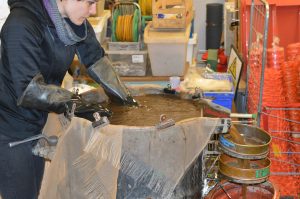 In March 2018, the final programme of post-excavation analyses of the archaeological remains at Carnoustie got underway with the wet-sieving of the soil samples taken during the excavation. This is the process by which we recover tiny minute environmental evidence (such as charred cereal grains) which might reveal the diet of the people who inhabited the site at Carnoustie during the Neolithic and Bronze Age.
In March 2018, the final programme of post-excavation analyses of the archaeological remains at Carnoustie got underway with the wet-sieving of the soil samples taken during the excavation. This is the process by which we recover tiny minute environmental evidence (such as charred cereal grains) which might reveal the diet of the people who inhabited the site at Carnoustie during the Neolithic and Bronze Age.
And just as the post-excavation analyses of the hoard began with a Post-Excavation Research Design so does this programme of work, laying out the key questions we want answers to and the various types of specialist analysis appropriate to each type of archaeological material that might answer questions like:
- What period or periods are represented by the artefacts and features?
- Can datable features reveal further patterns in distribution of activity across the site?
- Does the artefactual assemblage reflect a typical assemblage, reflective of the periods in question and is contemporary local/regional/national trade represented in the assemblages?
- Has settlement been continuous or periodic from the Neolithic to Later Bronze Age periods
- Are there discernible phases in the settlement of this site in the Neolithic and Bronze Age
periods? - How does the Bronze Age weapon deposits relate to the settlement activity and other
archaeological features, temporally and spatially? - How has the local environment changed over the sequence represented by the deposits sampled?
- What changes over time can be directly related to human intervention and/or natural processes?
- Is the environmental record reflective of sustained cultivation in this locale during the Neolithic/Bronze Age period? or is there evidence of other land use here?
